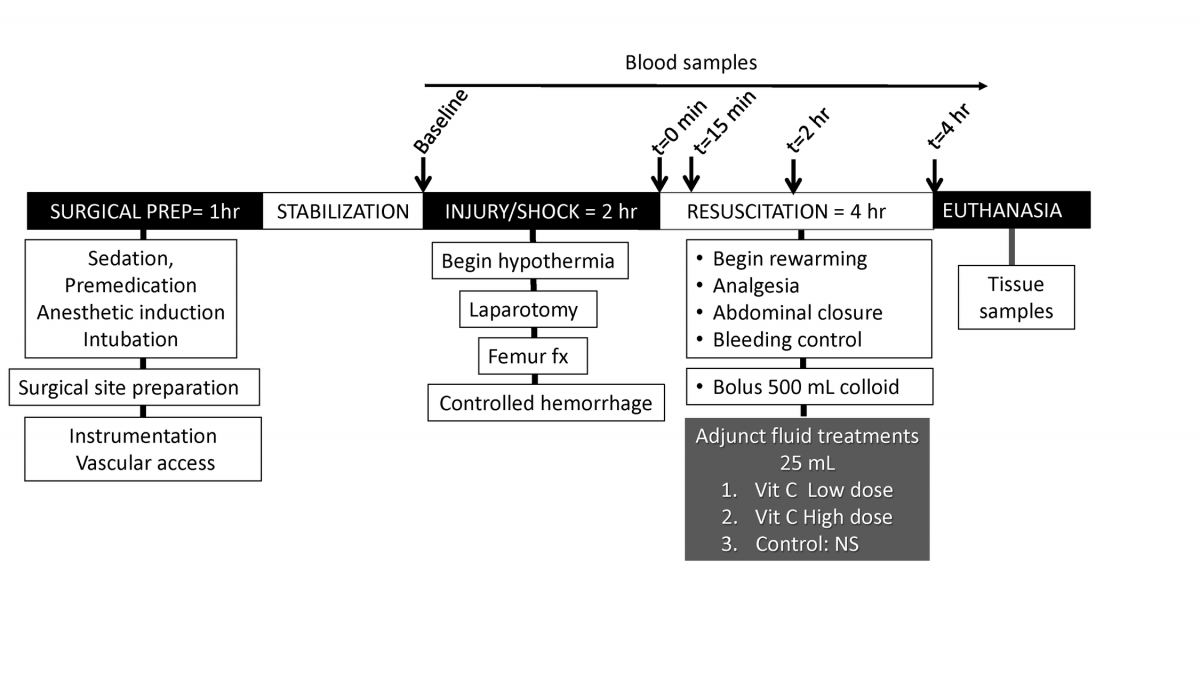9. Experimental procedures What was done, how it was done, and what was used. examples
For each experimental group, including controls, describe the procedures in enough detail to allow others to replicate them, including:
Example 1
“Fig … shows the timeline for instrumentation, stabilization, shock/injury, and resuscitation…Animals were food-deprived for 18 hours before surgery, but allowed free access to water. On the morning of surgery, swine were sedated with tiletamine-zolazepam (Telazol®; 5-8 mg/kg IM; Zoetis Inc., Kalamazoo MI) in the holding pen, weighed, and masked with isoflurane (3%, balance 100% O2) for transport to the lab. The marginal ear vein was catheterized for administration of atropine (0.02 mg/kg IV; Sparhawk Laboratories, Lenexa KS), and buprenorphine for pre-emptive analgesia (3 mg/ml IV; ZooPharm, Laramie WY). Ophthalmic ointment (Puralube®; Fera Pharmaceuticals) was applied to prevent corneal drying. Animals were intubated in dorsal recumbency with a cuffed 6 or 7 Fr endotracheal tube. Anesthetic plane was maintained by isoflurane (1-1.5%; 21-23 % O2, balance N2). Oxygen saturation (sPO2, %) and heart rate (HR) were monitored with a veterinary pulse oximeter placed in the buccal cavity (Masimo SET Radical-7; Irvine CA). Core temperature was monitored with a rectal probe and maintained at 36.5-38oC with a microprocessor-controlled feedback water blanket (Blanketrol® II, Cincinnati Sub-Zero (CSZ) Cincinnati, OH) placed under the animal. Anesthetic depth was assessed every 5 min for the duration of the experiment by reflexes (corneal touch, pedal flexion, coronary band pinch) and vital signs (sPO2, HR, core temperature).” [1]
Example 2
“For the diet-induced obesity (DIO) model, eight-week-old male mice had ad libitum access to drinking water and were kept on standard chow (SFD, 10.9 kJ/g) or on western high-fat diet (HFD; 22 kJ/g; kcal from 42% fat, 43% from carbohydrates and 15% from protein; E15721-34, Ssniff, Soest, Germany) for 15 weeks (https://dx.doi.org/10.17504/protocols.io.kbacsie).” [2]
Example 3
“The frozen kidney tissues were lysed. The protein concentration was determined with the Pierce BCA assay kit (catalogue number 23225; Thermo Fisher Scientific, Rockford, IL, USA). A total of 100–150 μg total proteins were resolved on a 6–12% SDS-PAGE gel. The proteins were then transferred to a nitrocellulose membrane, blocked with 5% skimmed milk for 1 h at room temperature and incubated overnight at 4°C with primary antibodies against the following proteins: proliferating cell nuclear antigen (PCNA; Cat# 2586, RRID: AB_2160343), phospho-AMPK (Cat# 2531, RRID: AB_330330), phospho-mTOR (Cat# 2971, RRID: AB_330970)…The β-actin (Cat# A5441, RRID: AB_476744) antibody was obtained fromSigma. The blots were subsequently probed with HRP-conjugated anti-mouse (Cat# A0216) or anti-rabbit IgG (Cat# A0208; Beyotime Biotechnology, Beijing, China) at 1:1000. Immunoreactive bands were visualized by enhanced chemiluminescence, and densitometry was performed using ImageJ software (RRID: SCR_003070, Bio-Rad Laboratories).” [3]
- Reynolds PS, Fisher BJ, McCarter J, Sweeney C, Martin EJ, Middleton P, Ellenberg M, Fowler E, Brophy DF, Fowler AA, 3rd, Spiess BD and Natarajan R (2018). Interventional Vitamin C: A Strategy for Attenuation of Coagulopathy and Inflammation in a Swine Polytrauma Model. The journal of trauma and acute care surgery. doi: 10.1097/ta.0000000000001844
- Bauters D, Bedossa P, Lijnen HR and Hemmeryckx B (2018). Functional role of ADAMTS5 in adiposity and metabolic health. PLoS One. doi: 10.1371/journal.pone.0190595
- Lian X, Wu X, Li Z, Zhang Y, Song K, Cai G, Li Q, Lin S, Chen X and Bai XY (2019). The combination of metformin and 2-deoxyglucose significantly inhibits cyst formation in miniature pigs with polycystic kidney disease. Br. J. Pharmacol. doi: 10.1111/bph.14558

